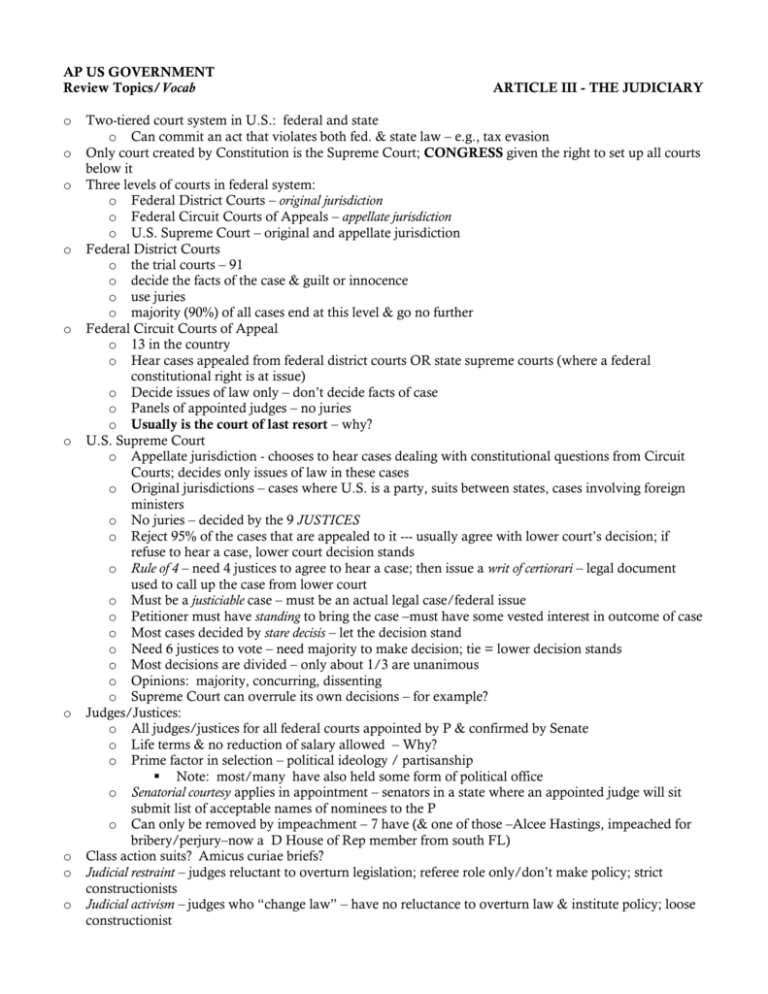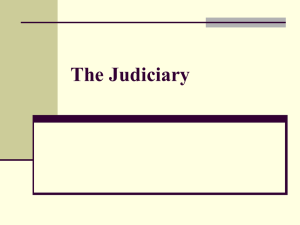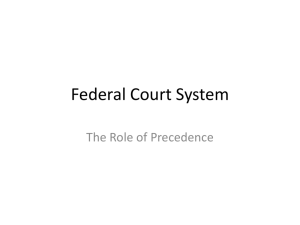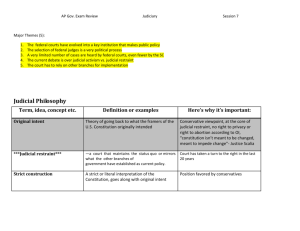ap us government - OCPS TeacherPress
advertisement

AP US GOVERNMENT Review Topics/Vocab o o o o o o o o o o ARTICLE III - THE JUDICIARY Two-tiered court system in U.S.: federal and state o Can commit an act that violates both fed. & state law – e.g., tax evasion Only court created by Constitution is the Supreme Court; CONGRESS given the right to set up all courts below it Three levels of courts in federal system: o Federal District Courts – original jurisdiction o Federal Circuit Courts of Appeals – appellate jurisdiction o U.S. Supreme Court – original and appellate jurisdiction Federal District Courts o the trial courts – 91 o decide the facts of the case & guilt or innocence o use juries o majority (90%) of all cases end at this level & go no further Federal Circuit Courts of Appeal o 13 in the country o Hear cases appealed from federal district courts OR state supreme courts (where a federal constitutional right is at issue) o Decide issues of law only – don’t decide facts of case o Panels of appointed judges – no juries o Usually is the court of last resort – why? U.S. Supreme Court o Appellate jurisdiction - chooses to hear cases dealing with constitutional questions from Circuit Courts; decides only issues of law in these cases o Original jurisdictions – cases where U.S. is a party, suits between states, cases involving foreign ministers o No juries – decided by the 9 JUSTICES o Reject 95% of the cases that are appealed to it --- usually agree with lower court’s decision; if refuse to hear a case, lower court decision stands o Rule of 4 – need 4 justices to agree to hear a case; then issue a writ of certiorari – legal document used to call up the case from lower court o Must be a justiciable case – must be an actual legal case/federal issue o Petitioner must have standing to bring the case –must have some vested interest in outcome of case o Most cases decided by stare decisis – let the decision stand o Need 6 justices to vote – need majority to make decision; tie = lower decision stands o Most decisions are divided – only about 1/3 are unanimous o Opinions: majority, concurring, dissenting o Supreme Court can overrule its own decisions – for example? Judges/Justices: o All judges/justices for all federal courts appointed by P & confirmed by Senate o Life terms & no reduction of salary allowed – Why? o Prime factor in selection – political ideology / partisanship Note: most/many have also held some form of political office o Senatorial courtesy applies in appointment – senators in a state where an appointed judge will sit submit list of acceptable names of nominees to the P o Can only be removed by impeachment – 7 have (& one of those –Alcee Hastings, impeached for bribery/perjury–now a D House of Rep member from south FL) Class action suits? Amicus curiae briefs? Judicial restraint – judges reluctant to overturn legislation; referee role only/don’t make policy; strict constructionists Judicial activism – judges who “change law” – have no reluctance to overturn law & institute policy; loose constructionist o o o Judicial review & strengthening of federal government by C.J. John Marshall: o Power established by Marbury v. Madison, 1803 o Upholding supremacy clause & implied powers of Congress – McCulloch v. MD, 1819 o Federal power controls over interstate commerce – Gibbons v. Ogden, 1824 2 ways in which the judiciary is insulated from public opinion: o lifetime appts., salary can’t be reduced Reasons why judiciary still takes note of public opinion o judicial decrees must be carried out by elected officials, can be impeached, have to be confirmed by elected officials, reputation of Court











